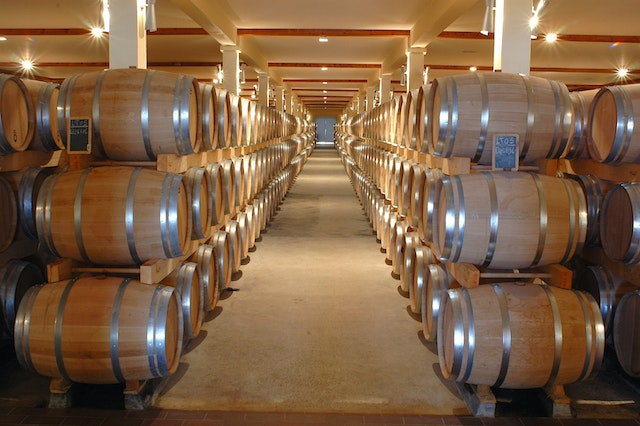
Why is oil measured in barrels? Oil is measured in barrels because that was the size of a wine barrel in 1866.
Nobody really knows when barrels were invented, but there is a picture of a wooden barrel made to measure wheat on the wall of the tomb of the Egyptian high official, Hesy-Ra, from about 2600 BC.
Someone who makes barrels is called a “cooper”, which gave rise to the surname Cooper. The word “cooper” comes from the middle German “kupe”, in turn from the Latin “cupa”, which meant “barrel”.
A barrel is made by arranging long pieces of wood, called staves, in a circle around the base of the barrel. The wood is usually oak, but any wood can be used. The staves are cut so that they are wider at the middle than at the ends, in order to have the bulge in the center of the barrel. This is so that the barrel is easy to roll and maneuver. Then hoops of iron are placed around the barrel to press the staves in. A barrel can be made completely watertight by soaking it in water for a few days. The oak wood soaks up water and swells, creating a tight seal between all of the staves.
There have always been many different sizes of barrels used for transporting different things. In medieval England, many things were sold in barrels and there were many different sizes of barrel. Merchants were largely unregulated, and corruption was a growing problem. One trick merchants used was passing off a smaller barrel as a larger one and trying to get more money. In 1483, King Richard III of England came to the throne. He was only king for a shade over two years, but during that time he passed a law that has impacted the oil industry. His legislation standardized a lot of weights and measures. The law said that a wine barrel (called a tierce) must be 42 gallons (about 159 liters).
Merchants that didn’t use the standardized barrel would lose trade, so it became the recognized size for wine barrels. After a while, it became the standard size for shipping most items, not just wine. Things that England sold abroad would be shipped in barrels of this size. A few hundred years after this, everything sent to English colonies was shipped in these standard sized barrels and it was taken up as a standard size there, too.
So, what does this have to do with oil? In 1859, Edwin Drake dug the first oil well in America, in Pennsylvania. This started an oil boom. Oil was coming up everywhere and the oil producers needed something to keep it in and something to sell it in. They started selling their oil in whatever barrels they had to hand. Quite often these were whiskey barrels, which were slightly smaller than wine barrels, but they would use any barrel they could get. In 1866, the major producers of this new oil industry met in Titusville, Pennsylvania. They realized that selling oil in a variety of barrel sizes was harming confidence in their business. They decided that they would standardize the barrel size and use the 42-gallon wine barrel as the official barrel of the oil industry. It just so happens that a 42-gallon barrel of oil weight 136 kg, which is just enough for one man to roll and manhandle it. So, they put an ad in the newspaper saying that they were only going to sell oil in 42-gallon barrels from then on, and that is what they did.
Oil was shipped in barrels on carts, trains, and boats for decades. The barrel industry became incredibly profitable until steel drums were invented in the 1930s. Wooden barrels, no matter how well they are made watertight, leak and are expensive to make, requiring skilled coopers. Steel is far more reliable and easier to mass-produce. Oil was shipped in these new oil drums that generally held about 55 gallons, 208 liters. Yet, oil was still measured in barrels.
Then pipelines became common, and oil was just pumped into tanks on ships, and then into tankers at the other end. Nobody uses barrels for oil, but oil companies still list the price of their oil by the barrel and publish how many barrels of oil they are producing. They use terms like MMbbl, which means one million barrels. (M comes from the Latin mille, meaning thousand. It is the same M in Roman numerals. So, MM is 1,000 x 1,000, which is 1 million.)
Oil is pumped through pipes but is still measured in barrels per day because a group of people in 1866 decided to use a barrel that King Richard III had standardized in 1483. And this is what I learned today.
Sources
https://www.goffpetroleum.co.uk/news/why-do-we-measure-oil-in-barrels-and-price-it-in-dollars
https://en.wikipedia.org/wiki/Barrel_(unit)
https://en.wikipedia.org/wiki/Drum_(container)
https://en.wikipedia.org/wiki/Barrel
